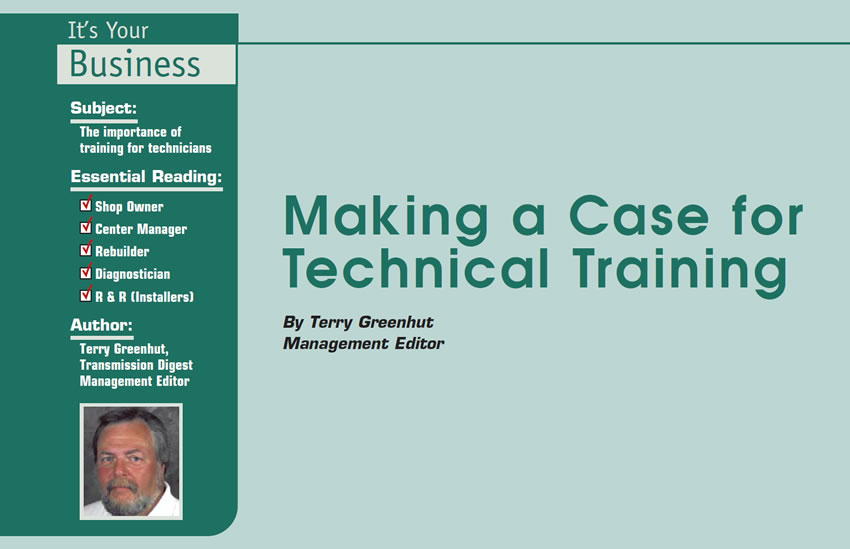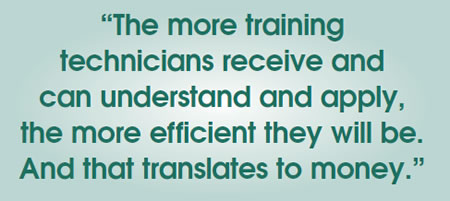
It’s Your Business
- Subject: The importance of training for technicians
- Essential Reading: Shop Owner, Center Manager, Rebuilder, Diagnostician, R & R
- Author: Terry Greenhut, Transmission Digest Management Editor
I’m writing this article while sitting at the rear table of a Saturday morning technical seminar. The topic is electronic troubleshooting. Should I be paying attention to what the trainer is teaching? Maybe, but learning troubleshooting techniques isn’t something I personally need to do anymore.
What I do care about is that the technicians from all the shops that attend learn what they need to know to make and save money for the businesses they represent. An even bigger concern is for the technicians whose bosses won’t send them or who can’t work up the enthusiasm on their own to come out and learn what they need to know. The more training technicians receive and can understand and apply, the more efficient they will be. And that translates to money.
Today’s transmissions and other vehicle systems are computer controlled and rely on small amounts of voltage to operate the sensors that tell the computer what it should know to open and close the solenoids and perform all other appropriate actions. Mistakes made in troubleshooting can translate to the loss of lots of money – not only the money it costs to fix the problem but also the revenue lost by not working on the paying jobs that are waiting in the parking lot.
Something as basic as making a wrong decision in the methodology used to begin the troubleshooting process can take you way out in the wrong direction. It’s like putting on the golf course. If you line up a 30-foot putt and think that it’s going to break 6 feet to the right so you aim 6 feet left of the hole but in reality it breaks 6 feet to the left, instead of the ball going in the hole or leaving you with a little tap-in putt you are now left with a 12-foot putt that, odds are, you aren’t going to make. So starting your troubleshooting by going in the wrong direction can leave you farther away from fixing the problem than you were before you began.

Although we have less time to troubleshoot today than we did in the past, it is more difficult to isolate problems than it ever has been. If we don’t do it right the first time we can waste hours or days, all of which converts to lots of lost profit.
Once you know how to troubleshoot and have all the right equipment, you have to learn to trust in what you know to be right. One of the scariest parts of the vehicle to condemn is the computer. Technicians will tend to try replacing far-less-expensive parts before they will go to the boss and say, “I need you to order me a computer for this car.” Even if all their diagnostic efforts indicate that without any doubt the computer is at fault, they will still try replacing parts that are far less expensive.
Many times the shop owner is the reason. When the technician has come to him in the past asking for an expensive part to be ordered, he gave the technician a sideways look and asked, “Are you sure you need that?” The technician, being afraid to make a $500 mistake and having been second-guessed so many times that he doesn’t want to be wrong again, refuses to trust his instincts and the result of his tests and decides that he should try a $40 speed sensor first. When it doesn’t work he’s wasted more time and money.
One thing that proper training along with hands-on experience teaches us is to trust in what we’ve learned and the equipment we paid so much to buy and learn to use. After all, if we do make a mistake once in a while or the equipment leads us down the wrong path, it won’t be very often. We will have gotten many more right than wrong.
Once more, a golf analogy: When in doubt, putt toward the middle of the hole. That way if you are wrong you won’t be very far wrong. By applying your experience and always using the most-up-to-date diagnostic technology you can’t be very far wrong. You’ll almost always be in the right ballpark if not 100% accurate.
Troubleshooting is not an exact science, as we all know, and it’s probably best that it isn’t. If there really were a machine you could hook up that would tell you exactly where the problem is and how to fix it, we would all be obsolete. Fortunately, it hasn’t come to that, and I hope it never will.
One of the fringe benefits of attending seminars given by experts who are other than factory speakers or trainers is that you are presented with real-world problems and fixes, not just the “follow-the-troubleshooting-tree” textbook rhetoric.
You get to see what happens, for example, when water rests in an area where an electronic component is mounted, and how its effects do damage over a period of time, yet this may not be true in all regions. After all, if the vehicle spends its time in the desert it probably will never exhibit the symptoms or the problem.
In a borderline wet area the problem may be present in only one out of 1,000 vehicles as opposed to one out of 100 in a place like Seattle where it rains so much. A hands-on type of trainer will have seen the problem many times and know exactly where to start looking for the solution, which would trim diagnostic time considerably.

Thinking or knowing that you are the best troubleshooter in your area because you’ve had training in real-world fixes for actual problems gives you a feeling of confidence that can easily be demonstrated in your pricing, your promotion and your outside-sales program. What you have to ask yourself is, “Am I the best?” If the answer to that one is a positive, then ask, “Do I save customers money by diagnosing problems right the first time?” Then ask, “What’s that worth?” Whatever it’s worth, that’s what you should be charging, and not a penny less.
Your marketing plan can revolve around the concept that you are a great troubleshooter. Phrases in your advertising might include one or more of the following: “No diagnostic problem too tough.” “We can diagnose and repair any automotive problem.” “Expert electronic diagnosis.” “We can fix the problems no one else wants to deal with.”
You can point out your considerable talents during outside-sales calls as well. Visit other automotive shops and offer your diagnostic services to them. If you really believe in your abilities, tell them you want the ones that have them stumped, the one’s they’ve given up on. Of course, you can charge top dollar for your services. After all, how much would you pay to get a car out of your bay when it was keeping you from doing other jobs on which you could be making money? It’s foolhardy economy to keep working on anything that you are no longer being paid to do. You’re far better off to get it out of the shop to make room for a paying job. Your technicians will thank you for doing that as well. They get frustrated when they can’t find an answer. If they work on flat-rate hours, it’s money coming directly out of their pockets, and they hate that.
To sell your diagnostic services to other shops you will need to show other shop owners how they have been losing money by working too long on vehicles they should have farmed out. Asking a few questions should reveal to you and to the shop owner whether your services are needed.
- 1) How many technicians do you usually assign to a job? The answer probably will be one.
- 2) How many technicians get involved in a “comeback or never-leave” situation? The answer generally will be two or more (if the shop owner is being honest).
Then say: “You do realize that for every hour your technicians work on that vehicle from the time the job first goes bad, you lose the productivity of them both.
For example, if your labor rate is $85 an hour and you have only one hour into the diagnosis, it has cost you $170. Run that to two hours and you have $340 in lost revenue. You know, Mr./Ms. Shop Owner, for considerably less than that we can usually have your customer back on the road and free your guys up to work on the next paying job. Do you think that might save you some money and a whole lot of aggravation?”
The only reasons other shop owners might decline to use your troubleshooting services would be that they don’t have the money or don’t want to spend it to let another shop fix the vehicle, or the shop owner’s pride and ego won’t allow him to admit defeat. Those excuses aside, troubleshooting for other shops could become a great source of additional revenue.

Visit www.TerryGreenhut.com.













